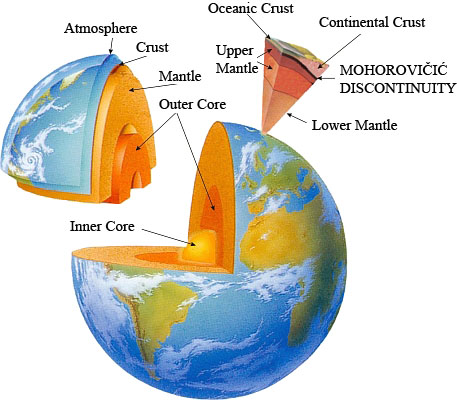The Earth
The process of accretion that formed the Earth was not a simple and by no means a peaceful process. Over the course of billions of years the Earth was bombarded on daily basis by space debris of all sizes: from objects the size of peas to objects the size of Mars. The process continues still today but not anything like it has in the past. Today the Earth recieves about one ton of space debri each year. This debri is mostly small dust grains that burn up as they fall through the atmosphere creating the objects typically referred to as falling stars. (Larger objects are still capable of impacting our planet as evident by Shoemaker-Levy 9 impact on Jupiter however are far less common).
During the early accretionary period earth was bombarded by much larger objects. Scientist currently believe that Earth was almost destroyed three times during it accretion. The last of these impacts is thought to have been so massive that it completely shattered the Earth and sent some debris into orbit around the Earth. It is this debris that is thought to have formed our Moon.
Other than forming our moon accretion, or more accurately the heat generated through accretion, is also responsible for the differentiation of the Earth. That is the separation of Earth into distinct layers that can be described based on the compositional properties of the materials contained within. The Earth can be divided into three distinct compositional layers: the crust, the mantle, and the core.
 |
| Depiction of the structure of Earth's interior |
The crust is the comparitively thin outer skin of the Earth. It is the layer we are most familiar with and the layer inwhich we live. At its thinest, at oceanic ridges, the crust can be as little as 3 kilometers (2 miles)deep. However, in mountain belts the crust can penetrate as deep as 70 kilometers (40 miles). The mantle is a solid rocky (silica-rich) shell that extends below the crust to a depth of about 2900 kilometers (1800 miles). Below the mantle is the core. The core is an iron-rich sphere with a radius of 3486 kilometers (2161 miles). It has a density of nearly 11g/cm3 (the crust and mantle have densitys of 2.7-3) and at its center the density approaches 14g/cm3.
Earth's interior is characterized by gradual increases in temperature, pressure, and density. Depending on the temperature and pressure a material is exposed to it may behave like a brittle solid, deform in a plastic-like manner, or melt and become liquid. Because of this fact the three main layers can be further divided and described based on their physical properties.
The lithosphere is Earth's outermost layer. It consists of the crust and the uppermost mantle. Because this region of the Earth is relatively cool and under little pressure the materials of the lithosphere behave like brittle solids. The lithosphere averages about 100 kilometers in thickness but may extend to 250 kilometers beneath continents.
Below the lithosphere the high temperatures and relatively low pressures allow a small amount of melting which detaches the lithosphere from the underlying asthenosphere allowing the lithosphere to move independently. The asthenosphere extends below the lithosphere through the upper mantle to a depth of roughly 600 kilometers.
Below the asthenosphere is the mesosphere. The mesosphere extends from a depth of 660 kilometers to 2900 kilometers. In this region rock is extremely hot and under enormous pressure. Although solid rocks of the mesosphere are capable of very gradual flow caused by convection.
Beneath the mesosphere is the outer core which is composed of liquid iron and nickel alloys. Convective flow within the outer core generates Earth's magnetic field. Beneath the outer core in the inner core. In this region pressures are so intense that the iron-nickel alloys are unable to melt and the materials behave like a solid.
